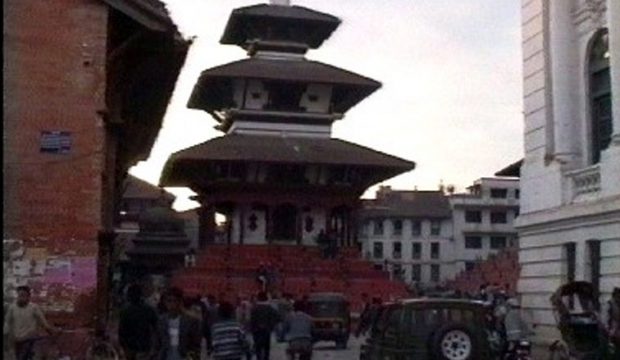
By the end of 1969 the first phase of SITA implementation in India had been completed and the three main centres : Bombay, Delhi and Calcutta were operational. It was the time of the flower people and the hippies were coming to India. However they soon discovered that Nepal was much more relaxed, cost of living was cheaper, as was cannabis.
There were actually two kinds of hippies : the real ones with little or no money, trying to survive by selling paintings or small things they had obtained from temples or other complacent places, and the fake hippies holding well provisioned credit cards. By then China was well established in Tibet and the hippies of the second category were observing what was going on in Nepal while trying to established some contacts in Tibet.
Annoyed with the troubles caused by such situation, since the first category of visitors were ending in hospital without money after having spent many nights sleeping in the streets and eating whatever was available whereas the second one were bringing political problems into the country, the Nepal’s government decided to put some order in the tourism Industry. First an entry visa was now required to visit the country, entry by air was preferred to land entry as was the involvement of tour operators to better handle the situation. Thai International was the airline which effectively promoted and started modern tourism in Nepal. With two Caravelle planes they were flying regularly between Kathmandu and Bangkok. The Kathmandu airport runway was too short and the aircraft had to deploy their emergency-brake tail parachute at each landing but that became a routine and it worked perfectly.
So, by the end of 1969, I considered that it was time for SITA to become involved. I went to Kathmandu in order to visit each airline’s on-line or off-line office as well as the tour operators. My conclusion was that the participation of the national airline was mandatory to justify the opening of a Kathmandu SITA centre, although Royal Air Nepal was still a very small airline. By chance while on board one of the flights I met the French Ambassador in Nepal who told me that France was going to provide a Caravelle to Nepal and that Rieffel, a former Air France man familiar with the area, will become the acting CEO of RNAC. I knew Rieffel, having previously met him in India, and I went to visit him immediately in order to check whether he was planning to join SITA. His answer was : « Of course I will but I wish you good luck before you can establish any reliable communication around Kathmandu ! »
I was quite familiar with that kind of situation in countries which were recently independant and facing a severe shortage of money. To solve the situation I would give Cable and Wireless Hongkong a verbal promise that I will order a leased circuit as soon as they have established proper RTTY circuits to the locality concerned. Then C&W would provide a TOR (Teletype On Radio) equipment and install it in the PTT premises and later get their money back from the revenue of public traffic and leased channels. We knew also by experience that as soon as leased circuits become available some Japanese customers like Bank of Tokyo or Mitsui will rent them thus shortening the time necessary for C&W to recover their investment.
Soon after, together with Louis Marias who was my assistant for the Indian Sub-Continent, I was back in KTM. There were 3 hotels in the city : l’Hôtel de l’Anapurna, the Yak and Yeti and an old Palace quite folksy decorated with large paintings of former maharajahs, however I never like that one since there were so many rats jumping on one’s bed at night that it was quite difficult to have a good sleep. There were also around many hippy-class guest houses and restaurants advertising : « pour touristes à moyens limités » or « for tourists with limited means ». We opted for Hotel de l’Anapurna where we had as room neighbours, Serge Gainsbourg and Jane Birkins who were shooting the movie « Les chemins de Kathmandou ».
The city is relatively large so the use of rickshaws was not convenient and as there were only a limited number of taxis we hired bicycles. I still remember Marias sweating while pedalling behind me as we had to rush from offices to offices, to PTT and ministries, in order to convince various ministers and managers that they should authorise SITA to operate in Nepal and then to get them moving forward, a much more complex exercise that it can appear while reading these few lines. Then getting the local lines implemented and working fine between the PTT, the SITA centre and the airlines offices was another step forward requiring constant pressure over the authorities concerned, but at least for once we had the national airline supporting our proceedings.
Once everything had been agreed and was starting moving ahead I entrusted Marias with the fitting up of the centre and the recruitment of the staff while providing him with some technical support from Bangkok to complete the installation.
By 16 January 1970 the new Kathmandu centre was ready. The minister of communications wanted to open the telecommunication link himself by pushing the button starting the transmission to Hongkong with the first message written on perforated tape. I attended the ceremony and I had told Sam Weller in Hongkong to remain on site in order to send a reply to the minister’s message. All went well and Rieffel, by then CEO of RNAC, appeared well satisfied with the new set up and service. He sent a message to G. Monniot stating « Thanks to the dynamism of Leroy and his team Royal Nepal Airlines is now linked to the rest of the world ». That was nice and Monniot who happened to be available at that moment acknowledged it immediately.
But long interruptions of circuits were still too frequent, many of them caused by uncommon and unexpected events. For instance during a Hindu festival there were various processions with people pulling high wooden towers on wheels. Since the local lines were all aerial and crossing the streets they were all pulled down and all means of communication either telephone or teleprinter were cut off for quite some time before being repaired.
Then came a long drought and as the electric power was supplied by hydro-electric dams, power outages became too frequent and we had to import an emergency power unit from India but the cumulative effect of red tape for the exportation from India and the crossing of part of the Himalaya by roads still in very poor conditions took a very long time. But things improved steadily and RNAC was appreciating SITA services as we constantly reacted promptly to any negative event.
Some years passed, RNAC decided to move to a new building and we followed them. There is in Kathmandu a living goddess, the Royal Kumari whose body is inhabited by the goddess Taleju, the chief protective deity of Nepal. The Kumari is selected among young girls from the Newer Shakya caste by a committee of Hindu priests and she, from then on, lives in her own temple at Dubar Square. Once appointed her feet should never touch the soil, she will not wear shoes as usually visitors will kiss her feet. She will travel in a palanquin or a guardian will carry her in his arms whenever necessary. The Kumari, or more probably Taleju the goddess she hides, is supposed to be very powerful and many politicians or CEOs will meet her before taking major decisions, asking for her spiritual support. The Goddess Telaju will leave the Kumari’s body when the latter has her first menstruation, or will lose blood for any other reason, and another girl will have to be selected.
So this time it will not be the minister of Communication but a living Goddess who will be entering our building to which a solid future will be assured by her sole presence. I was wondering whether my colleagues of Cyprus or Greece were receiving on some occasions the visit of Aphrodite (Venus) born adult from the foam of the sea and Goddess of love and beauty… but even while working in the field of communication that is probably the kind of query to avoid if one wants to be taken seriously!
The whole retinue entered the courtyard (picture 07) with the musicians in front followed by the bearers of the Kumari’s palanquin. At the main gate our Chief of centre, Shah Sitaram, made an offering to the bearers (pic.10) while an attendant took the Kumari in his arms in order to climb the steps. At that time I became the lucky recipient of her attention (pic.11), quite happy since such interest from her part supposes to bring good luck to the person concerned.
But ceremonials such as the inauguration of a new building require at least the sacrifice of a goat. Doing it in the centre was out of question. We could consider doing it in the emergency power room provided good care is taken to avoid the blood flowing into the alternator or other electrical parts causing a short circuit. Finally common sense prevailed and the goat was sacrificed in the courtyard.
I shall end here my relation of the implementation of SITA in Nepal. At that time a second centre was already operating at Pokhara, tourism was developing rapidly and all the environment was changing as the country was moving forward, but what remains in my mind is the open, friendly and positive attitude of the Nepalese people I have met when completing these projects.
Bernard Leroy
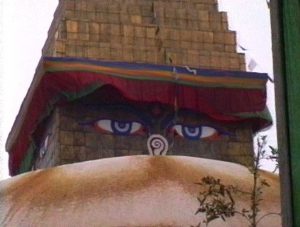
Kathmandu,
top of main stupa

Kali, spouse of Siva, God of destruction and rebirth
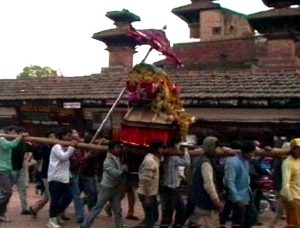
a Hindu procession
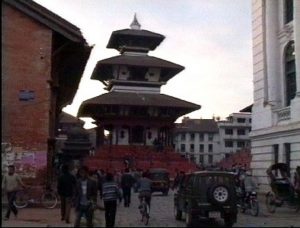
a Hindu temple
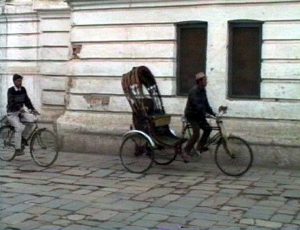
a cyclo-taxi
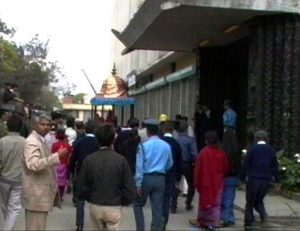
on the left wearing a jacket, Shah Sitaram, KTMXC.
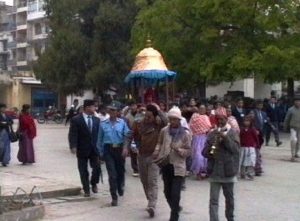
the Kumari procession entering the courtyard (#07)
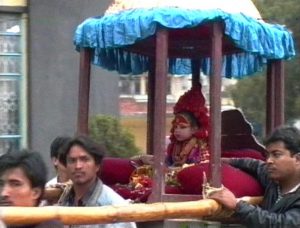
the Kumari on her palanquin.
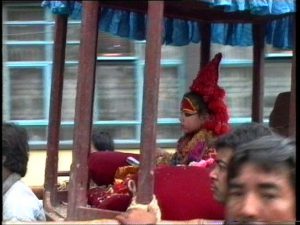
The Royal Kumari

the Kumari passing the main gate. (#10)
(KTMXC on the right side)

bearing the Kumari for climbing the steps. (#11)
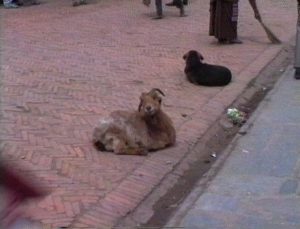
a common goat, like the one being sacrificed

a Nepalese temple
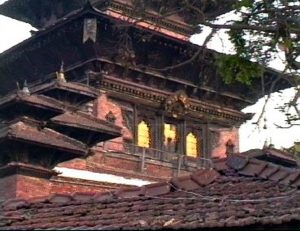
a Nepalese temple

Kathmandu at sunset
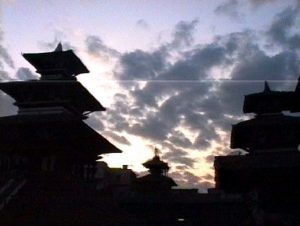
Kathmandu,
Skyline at sunset
Commentary :
From John Lockwood:
Hi Bernard
just read it, it would be hard for any geek these days to understand the problems we had with PTT’s in those days, the sheer obstinacy of most of them wrapped in the red tape of government departments. With mind-sets of charging by each word of telegrams and considering we were doing them out of revenue.
Even the Civil Aviation Departments who were very restrictive which in the case of NZ changed directly overnight from a government department to a government owned private enterprise who had to source their own revenue. I had met a brick wall in trying to lease some equipment space in their repeater sites within NZ to allow AirNZ’s own ground/air HF/SSB stations when it was suddenly all co-operation when civil servants turned into business entrepreneurs by the stroke of a pen. In the end we had all the space we needed free, provided we allowed them to use our SSB system to broadcast Notam weather every half-hour for 5 minutes to all international incoming aircraft. This suited us fine as a large number of aircraft at that time were AirNZ.
I remember taking the first modem down to Wellington PTT for type approval, we wanted to put it on the AKL/SYD cct we shared with QF, the PTT hadn’t seen one before! I still remember which one it was, a Racal-Milgo 4800/24PB, the PB was a piggy-back voice channel using the outer bands, people using the PB sounded like Donald Duck but we were happy we had a ‘free’ voice channel. Pioneering data! People take the internet for granted but are not aware of how it all came about.
brgds John
